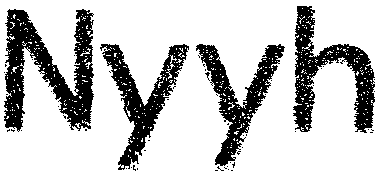Opus phase iii (2023) is an installation by Kolya Kotov that consists of a series of kinetic objects. It was originally presented at Kuvan Kevät 2023, MFA graduation exhibition at the Academy of Fine Arts Helsinki. In the artwork Kotov combines various mediums: weaving together elements of photography, performance, moving image, installation and sculpture.
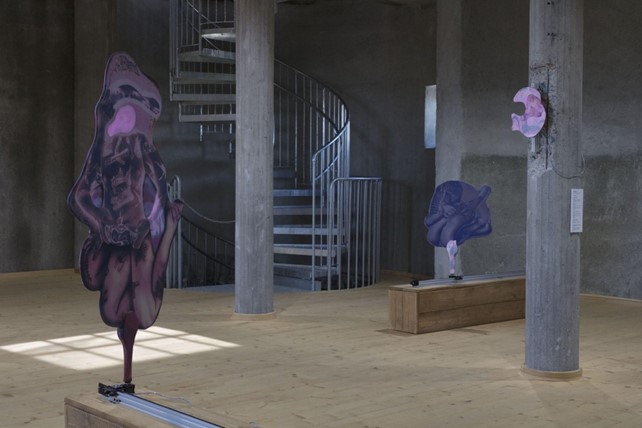
Telma: Reflecting your practice and working with a wide range of mediums, we talked about the technology, the aluminum rails and motors, you worked with when making opus phase iii. How did you choose the materials for the work?
Kolya: I actually never worked with that technology before, but I like experimenting and challenging myself. One of the points in your questions was, how did you say it, that you haven’t seen anything like that before, and that was one of the main goals when I was doing the work. I wanted to create something unseen. That’s also what I write about in my thesis. So, another reason for this work, or the technique that I chose, was my concerns about what materials and facilities would be available for me after graduation, so I gathered the equipment that I could continue working with in the future by combining them in different ways. The first plan that I didn’t execute was supposed to be a composition of four objects where the rails would be placed together. However it was too difficult to execute within the time frame considering that I never worked with that kind of programming before, so eventually I gave up and decided to separate the elements. But I’m still going to continue developing that idea.
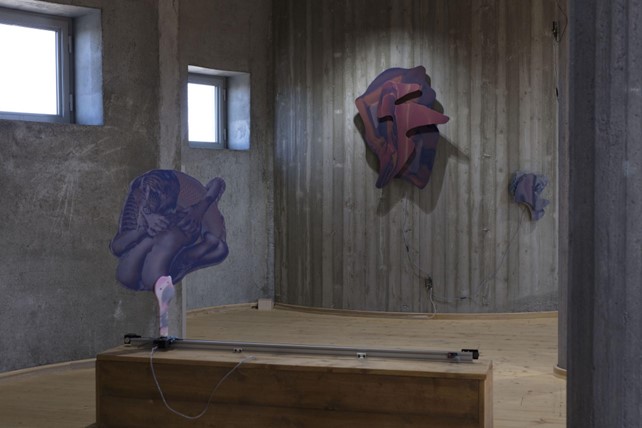
The sound is creating a captivating atmosphere; the kinetic objects start moving one at a time and then suddenly they are all moving and making a sound together until it becomes silent again. It’s almost like the artworks are communicating with each other with a frequency one can hear and feel but not quite understand. How did you create the sound?
The sound was actually produced by the motors and the rumbling of the belts dragging the objects. It was not planned, it was discovered during the process. The technicians here at KuvA suggested a way to eliminate the sound, but I didn’t mind it. However, I did adjust the frequency of the sound. It was interesting how it could be adjusted by changing the speed and the mode of the motors. Some of the sounds were really wild and really disturbing, so I tried to make it more bearable. Also, it’s interesting how the sound was affected by the rotation of the objects attached. That was also something I tried to play with. Most of the programming was made with certain time intervals, meaning that they would never move in the same choreography with each other. So there were also moments when all of them were still or all of them were moving together. Always a bit different. I am considering to continue working with the sound that the work produced by developing it into a performative work in which I would control the sound of moving elements in real time. It’s interesting how in the development of a work you can find something surprising to work with further.
You mentioned that you have a background in studying fashion. Do you feel that it has an impact in your artistic practice? How was the change from studying fashion to fine arts like?
I hadn’t worked with art before I started studying at KuvA. The year before that I was applying to Aalto Master’s in Fashion, but wasn’t accepted. Then my partner who was studying at KuvA at the time suggested that I consider applying to the Academy of Fine Arts. To be honest, my experience in the fashion industry left me unsatisfied, primarily due to the global issues of overproduction and overconsumption. Although I was working on my own brand, my limited knowledge of brand development held me back. Most of my efforts involved hand-painting garments for private clients and creating small seasonal collections of printed apparel. The repetitive nature of this work eventually led to dissatisfaction. Upon acceptance to KuvA, I initially tried to downplay my previous knowledge and skills in textiles. I felt a stigma associated with transitioning from the design fields to the arts, as I was unfamiliar with the art scene and perceived it as somewhat stigmatized. In my first couple of years at the art academy, I exclusively focused on performance, video, and photography, attempting to distance myself from my design background. Eventually, I began incorporating my previously acquired knowledge into my artistic practice.
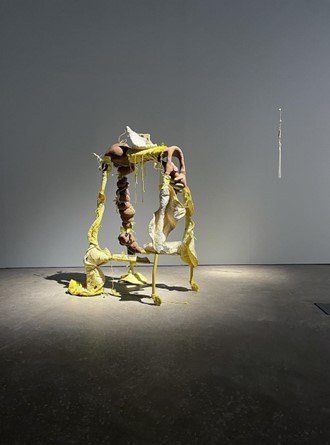
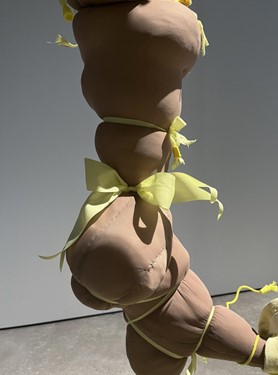
afflatus phase ii (2022)
in Kuva/Tila time and space group exhibition
On your website you write about afflatus phase ii (2022): ”i love changes”. Change and movement create a sense of narrative in and in between your works. How do you see afflatus phase ii in relation to your master’s project opus phase iii?
I see afflatus phase ii as a transitional work between my bachelor’s and master’s projects: In afflatus, I’m trying to move away from the notion of the human body. My bachelor’s exhibition work was mainly based on my experience of becoming physically disabled just before I started the work on the project, therefore it became very corporeal work with my body depicted in a video that was part of an installation. But same time as a queer artist, I was thinking a lot about the definition of human, and how we position ourselves as superior instead of trying to co-exist with everything around us. So for afflatus, I wanted to have only a small resemblance to a human body, I felt like I used my own body too much in my previous works and I wanted to separate from that somehow.
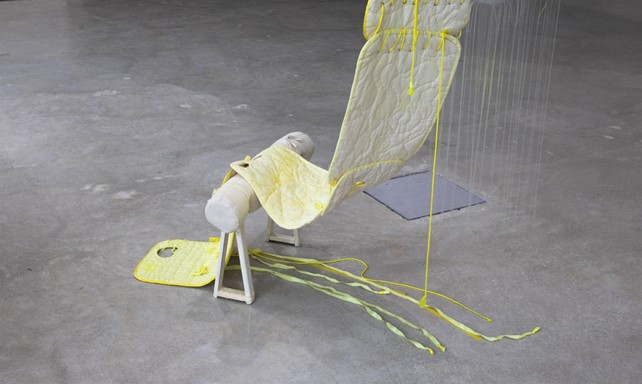
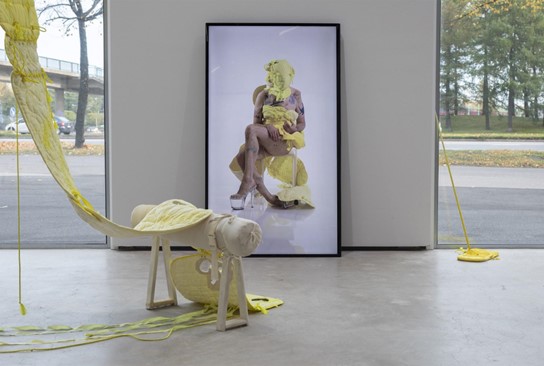
yellow phase i (2021)
In both afflatus phase ii (2022) and yellow phase i (2022) yellow is the dominating color. Why did you choose yellow?
I was diagnosed with bone cancer in 2020 and underwent surgery within two weeks to remove the tumor from my shoulder blade. This operation resulted in my shoulder becoming fully dysfunctional. During my research, I discovered that yellow is the color associated with awareness of bone cancer, similar to the well-known example of pink representing awareness of breast cancer. Additionally, I learned that yellow is also a symbol for individuals who identify outside of the gender binary. Intrigued by these connections, I began collecting information on the various meanings of the color yellow. This exploration led to the incorporation of yellow not only as the central theme of my bachelor’s thesis but also as the namesake for the artwork. The entire textile piece was hand-stitched, a process that demanded a considerable amount of time. I started working on it just a couple of months after the surgery. Due to the movement limitations of my shoulder, using a sewing machine was not possible. Consequently, the decision was made to exclusively work by hand, devoid of any machine interaction. The textile work was crafted with the concept of diversity in mind, allowing it to be adaptable to various human bodies, non-human bodies, and the spaces in which it was exhibited.❍
Telma Pietiäinen
All images courtesy of the artist.
